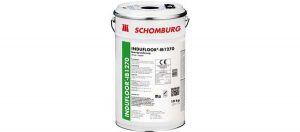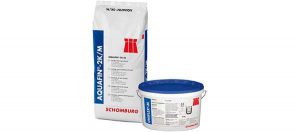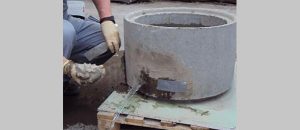ASO®-Fugenbunt Art.-No. 2 04273
Fine grain grout
• For interior use
• Can be washed off early
• Smooth consistency
• Vapour permeable
• Cures free from cracks
• Good application and wash-off properties
• Resistant to freeze/thaw cycles
• For heated floors and walls
• Free from the silicosis hazard – fine quartz dust
• Colours matched to the ESCOSIL-2000 range
• Fulfils the requirements for CG1 to DIN EN 13888
• For joint widths from 1.5 to 6 mm
Areas of application:
ASO-Fugenbunt is especially suitable for grouting absorbent ceramic tiles made from red or white bodied biscuit. The grouting performance, the stiffening in the joint, the water retention and the wash off properties are tailored to suit these tiles. ASO-Fugenbunt is used for joint widths up to 6 mm in interior areas, on walls and floors, in dry, splash contact and wet areas. For grouting floor areas we recommend ASO-Flexfuge, for heavy duty areas HF05 Brillantfuge or ASODUR-Design. For grouting natural stone, fully vitrified and other tiles with low water absorption, glass mosaics and tiles, we recommend CRISTALLFUGE PLUS.
Technical Data:
Composition: cement, mineral aggregates and high quality additives
Colours: white, silver grey, manhattan (colours, see table on the last page)
Joint widths: 1.5 to 6 mm
Pot life *: approx. 60 mins
Substrate / application temperature: +5° C to +25° C
Foot traffic after *: approx. 12 hrs Full service
conditions after *: earliest 2 days
Water demand: 5.0 – ۶.۰ litres / 20 kg or 1.25 – ۱.۵ litres / 5 kg
Consumption: see consumption table
Cleaning: whilst still fresh with water
Bulk density: approx. 1.26 kg/dm3
Fresh mortar density: approx. 1.9 kg/dm3
Packaging: 20 kg and 5 kg bags
Storage: dry, 12 months in the original unopened packaging. Use opened packaging promptly. * Values relate to +23° C room temperature and 50% relative humidity.
Product application:
Once the adhesive bed has set, rake out the tile joints to an adequate depth. Without too much water, wash the tile surface. The adhesive bed must be fully hardened otherwise there may be discolouration. Pre-wet very porous tiled finishes. The joint edges must be clean and free from separating substances. The time at which grouting can commence depends on the adhesive used and can be between 3 and 72 hours. When tiles have been fixed in sand:cement mortar, the mortar must be adequately hard and be evenly dry. Do not grout areas which have differing surface temperatures (e.g. caused by sunlight). Adjust the consistency of the grout to suit the absorbency of the tile and the substrate.
1. Stir ASO-Fugenbunt with clean water in a clean mixing bucket. Use 1.25 to 1.5 litres of water, depending on the desired consistency and add 5 kg ASO Fugenbunt and mix to a smooth homogenous consistency.
Vitrified tiles:
Approx. 1.25 – ۱.۳۵ litres water : 5 kg ASO-Fugenbunt
Red or white bodied biscuit
tiles:
Approx. 1.35 – ۱.۵
litres water : 5 kg ASOFugenbunt We recommend using a suitable rotary mixer to mix (mixing speed approx. 300 – ۵۰۰ rpm). Allow the grout to stand for 2 minutes, then remix. In order to avoid colour variations, keep to the same mixing ratio.
2. Work the ASO-Fugenbunt into the wall or floor tile joints using a grout float and light pressure. Strike off diagonal to the joints so that the joint section is completely filled. In order to ensure the joints are completely filled in one application, only strike off excess grout cleanly and diagonally to the joints after a short wait (30 – ۶۰ seconds).
3. Once the grout has stiffened (check with a finger test) wash the grout contours with a dampened sponge. After a few minutes wash clean with a sponge board.
4. Keep movement joints free for elastic sealing with ESCOSIL-2000. Rake out adhesive residues once stiffened and wash down with a lightly dampened sponge.
5. Any remaining grout haze can still be washed away with a sponge board and clean water after a few hours. When cleaning do not use a dry cloth, as there is the risk of discolouration from rubbing dried grout into the joints which are still damp. Protect the fresh grout from influences which will affect the cure such as high temperatures, wind, rain or frost. In unfavourable weather conditions (low humidity, draught, wind) and with very porous tile bodies, optimum curing of the grout is aided by post-wetting the joints with clean water (re-wetting with a sponge board). Change the wash off water frequently with fresh. It is recommended that a trial area of grouting is carried out (possibly also lightly pre-wetting the surface) with ceramic tiles which have a profiled, rough, unglazed or porous surface or tiles with a craquelure glaze as well as natural stone with a rough surface texture and with polished ties, which contain micro-pores in the surface of varying sizes. The time to wash off depends on the type of material installed and the prevailing climate. After an adequate waiting time, smoothen the surface without washing the grout from the joints.
Improtant advice/ frequent application mistakes:
• Do not attempt to re-life grout which has started to stiffen by adding more water or fresh powder as there is a risk of discolouration.
• Only use clean water and clean tools.
• Carefully clean the substrate before commencing grouting.
• Note the setting time of the adhesive or mortar. There is a risk of discolouration if grouting is carried out too early.
• The formation of bubbles or pin holes in the joint has been found following inspections to be unrelated to the grout. The following general conditions are, as a rule,
the cause:
1. Highly porous ceramic
2. High water/cement ratio in the grout
3. Air entrained into the grout
For 1 & 2: do not pre-wet red/white bodied high density biscuit tiles, but using a sponge board thoroughly pre-wet those with lower density and consequently high porosity and capillarity before grouting.
For 3: If a high speed or inappropriate paddle design is used, then an increased amount of air can be entrained. To overcome this, where appropriate, vibrate/ bang the fresh mortar whilst the entrapped air visiblyescapes. A round or helical paddle has proven to be advantageous.
• In draughts or strong sunlight, protect the joints from drying out too quickly, possibly by covering with polythene or through continued dampening of the joints.
• Joints between tiled bays, around interruptions and pipe penetrations as well corner and junctions are to be sealed with ESCOSIL-2000, ESCOSIL-2000-UW or ESCOSIL-2000-ST, dependent on the type of application.
• For cleaning and maintenance, we recommend, the exclusive use of neutral or slightly alkaline cleaners. Once the surface has been cleaned, rinse with clean
water. Watch for even porosity of the substrate and joint edges.
• When using acid based cleaners, follow the relevant regulations. Refer to the specific properties of the adhesive bed. Wet the joints and then apply the cleaning agent – at weak application concentrations. Restrict the action time of the cleaner to a minimum and always rinse off with plenty of water afterwards. Acidic cleaners reduce the strength and solidity of the grout and may completely destroy the grout matrix if used improperly such as e.g. at too high a concentration, if left to act for too long or by omitting the pre-wetting stage.
• Uneven moisture penetration from the sub-base, mortar bed, temperature variations or tile types can lead to colour variations within the grout finish, which do not affect the quality of the grout and which may even out under favourable environmental conditions. There is no guarantee against colour variation.
• In heavier duty areas e.g. where there are cleaning
machines or there is exposure to chemicals, we recommend, dependent on application, the high resistance two component epoxy resin grouts ASODUR-EK98, ASODUR-Design, or HF05-Brillantfuge.
• Prior to grouting, seal off perimeter and movement joints with an insulation strip RD-SK50 to prevent filling with mortar.
• Due to sensitivity to contamination, only use light colours in building interiors and on walls.
• Only use material from the same batch within the same room.
• To optimise hydration ensure there is adequate moisture available. This is particularly valid for non-porous tiles as there is no depot effect expected.
• Before grouting natural or agglomerate stone tiles refer to the specific properties of these products (tendency to discolour). We recommend that a trial area is carried out.
• Protect areas not being grouted from ASO-Fugenbunt. Please observe a current EU Health & Safety data sheet.
GISCODE: ZP1




